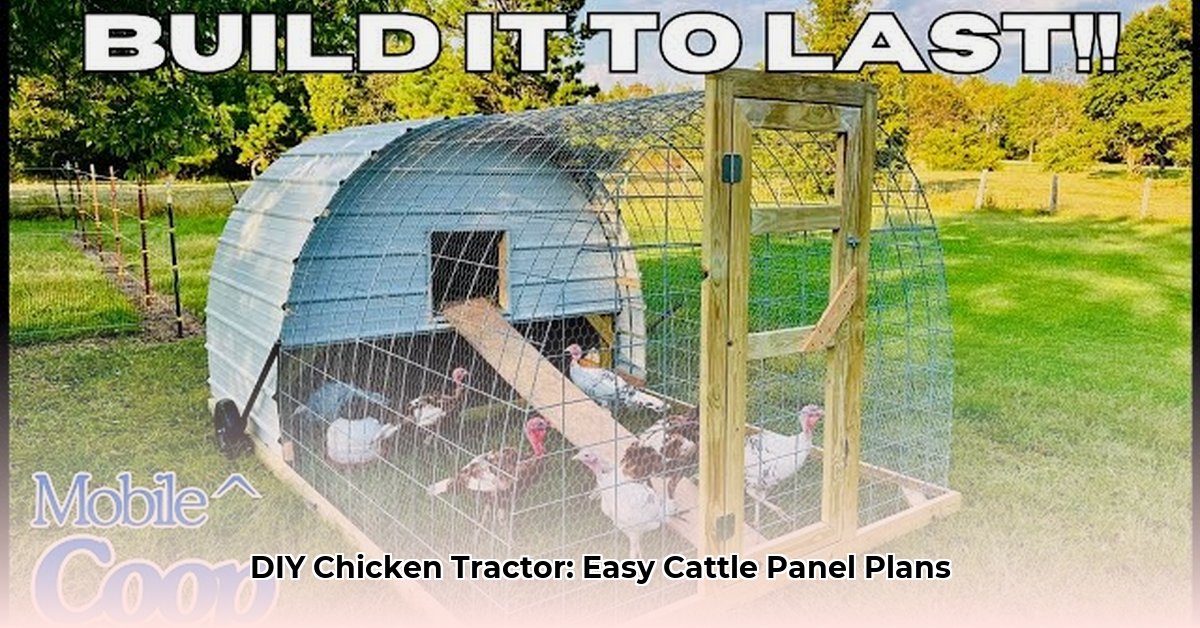
Chicken Tractor vs. Stationary Coop: Choosing the Right Housing
Raising chickens offers fresh eggs and a connection to nature, but providing safe and comfortable housing is crucial. Cattle panels offer an economical and surprisingly versatile solution, allowing you to build either a mobile chicken tractor or a stationary coop. This guide provides a comparative analysis and step-by-step instructions for both, empowering you to choose the best option for your needs and skill level. Whether you're a small-scale farmer, a DIY enthusiast, or a sustainable agriculture advocate, this guide will help you build the perfect home for your flock. For pre-built options, check out these chicken tractor kits.
Comparative Analysis: Mobile Tractor vs. Stationary Coop
Deciding between a mobile chicken tractor and a stationary coop involves weighing several factors. Both offer unique advantages, but which one best suits your situation? This comparison will help you decide.
| Feature | Mobile Chicken Tractor | Stationary Coop |
|---|---|---|
| Cost | Moderate (higher initial investment due to wheels and more materials) | Low (generally less expensive upfront) |
| Ease of Construction | Moderate (more steps, requires mobility features) | Easy (simpler design, fewer moving parts) |
| Predator Protection | Requires significant security measures (hardware cloth is essential) | Moderate to High (requires careful planning and construction; strong materials are needed) |
| Durability | Moderate (panels may bend under heavy use; wheel strength is crucial) | High (can be built considerably sturdier) |
| Mobility | High (easily moved to fresh pasture) | None (permanent location) |
| Maintenance | Moderate (regular checks for wear and tear) | Low (generally less frequent maintenance) |
(Note the crucial role of hardware cloth in predator protection for both options. This is not optional.) Isn't it interesting how mobility impacts other factors like cost and ease of construction? A stationary coop, while simpler to build, offers less flexibility. A mobile tractor requires more effort, but the benefits are numerous.
Building Your Mobile Chicken Tractor: A Step-by-Step Guide
This section provides a detailed guide to building a mobile chicken tractor using cattle panels. Remember, safety first! Wear safety glasses and work gloves throughout the process.
1. Gather Your Materials: You will need: cattle panels (sufficient to create a rectangular or square enclosure for your flock size), heavy-duty hinges, sturdy wheels and brackets (essential for maneuverability), hardware cloth (to prevent predator access – absolutely critical!), wire cutters, zip ties or wire for securing hardware cloth, and a simple latching mechanism for the door. Consider adding a tarp or other lightweight roofing material for weather protection.
2. Construct the Frame: Connect your cattle panels using hinges, creating a rectangular or square base. Ensure hinges are securely fastened. Consider adding additional panels to increase height, but remember that a heavier tractor will be more difficult to move.
3. Attach the Wheels: Securely attach wheels to one side of the tractor frame using the wheel brackets. Invest in heavy-duty wheels for optimal maneuverability.
4. Install Predator Protection: This step is paramount! Use hardware cloth to completely enclose the bottom and sides of your tractor. Secure it tightly using wire or zip ties, leaving no gaps for predators to exploit.
5. Create the Door: Cut a section from one panel to create an easily accessible door. Install a secure latch.
6. Add a Roof (Optional but Recommended): To protect your birds from the elements, consider adding a simple roof. A tarp stretched over the structure and secured works well.
7. Final Touches: Add any extra features, such as a nesting box, and consider applying a coat of paint to protect the panels and enhance aesthetics.
Building Your Stationary Chicken Coop: A Step-by-Step Guide
A stationary coop offers a more permanent and potentially more secure housing solution for your chickens. This guide details the construction process.
1. Design and Planning: Sketch your coop's dimensions, considering the space requirements for your flock. A larger coop is always preferable to a cramped one.
2. Build a Foundation: Create a robust base using treated lumber to ensure a level and stable foundation. This will support the weight of the structure and prevent moisture damage.
3. Attach Cattle Panels: Secure cattle panels to the frame, creating the walls of the coop. Ensure tight connections to prevent gaps.
4. Construct the Roof: Build a durable roof using appropriate materials like asphalt shingles or metal roofing, ensuring sufficient overhang to protect walls from rain.
5. Install the Door: Cut a door opening and hang a sturdy door using hinges. Secure it with a robust latch.
6. Add Ventilation: Proper ventilation is essential to prevent moisture buildup and maintain comfortable air quality. Include ventilation openings at the top and bottom, screening them to prevent predator entry.
7. Install Nest Boxes: Construct or purchase nest boxes and place them at a height suitable for your hens.
8. Finishing Touches: Apply a protective coat of paint or wood sealant to enhance durability while adding an aesthetic touch.
Making the Right Choice: Mobile or Stationary?
The ideal chicken housing solution depends on your individual circumstances. Consider land availability, predator prevalence in your area, and your personal preferences. For beginners, a stationary coop might be simpler to build. However, a mobile tractor offers superior pasture rotation possibilities, minimizing soil contamination and enriching the chicken's environment. Choose what best fits your needs and resources. A well-constructed coop, regardless of the type, will result in happy, healthy chickens.